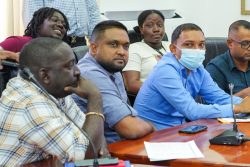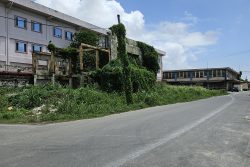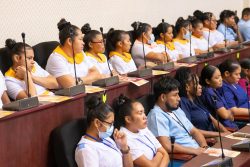Dear Editor,
I want to refer to Eric Phillips’s letter of April 12, 2008 in Kaieteur News and Walter Samuels of April 15, 2008, in Stabroek News.
When the Guyanese people have fought so hard to institutionalize freedom of speech and freedom of expression, here comes Eric Phillips telling some of us to keep quiet; and I suspect he wants to become a political leader. Indeed, given his excessive ambitions to become such a political leader and his consistent disdain for freedom of speech, the Guyanese people must see him as suspect.
Phillips should know that Hinds’ discussion and qualitative application of marginalization prevents a lucid conceptualization of the marginalization framework. While useful, a better understanding of social (not political or cultural) marginalization will emerge from a quantitative comparison of participation levels of ethnic groups in society.
And so given the limitations of a qualitative application of marginalization as presented by Phillips through Hinds’ work, all the ethnic groups at the lowest levels of the class structure in Guyana would have experienced (a) through (g), as mentioned in Phillips’s letter.
For instance, not only Africans, but Amerindians, Indians, Portuguese, and the mixed at the lowest tiers of the class structure may tell you that they do not have equality of opportunity with other groups; and perhaps feel exploited in the workforce without adequate compensation, etc.
And, indeed, each ethnic group faces not only the societal-wide class structure, but also an intra-ethnic class structure.
And so following Phillips, it would appear as if all ethnic groups at the lowest class tier are marginalized; what they are experiencing, however, are conditions of disadvantage that could lead to marginalization.
The point, however, is that not everyone who experiences disadvantage is necessarily marginalized; people’s adaptability levels vary across ethnic groups; some may convert the condition of disadvantage into a condition of advantage, while others may be unable to do so.
But this is precisely Phillips’ allusion erroneously implying that marginalization is a condition. And so, too, Samuels’ examples of marginalization really are conditions of marginalization, but not necessarily marginalization.
However, marginalization is a process, not a condition; the condition itself is not marginalization, but could lead to marginalization. Given that marginalization is a process, the individual can experience marginalization in some parts of the life cycle and not in other parts.
The Copenhagen School explains that “Marginalization can thus be defined as a process where there is a more or less comprehensive involuntary exclusion from participation in one or more spheres of life. A process where there is a normative expectation of participation both as regards the individual and in relation to the given socially dominant norms and practice.”
And so since marginalization is a condition of disadvantage, a review of the types of marginalization is appropriate. There are three types of marginalization. First, we have cultural marginalization where a minority group shares some cultural aspects of the dominant group, but also shares other cultural facets with one or more minority groups. In effect, the marginalized person is estranged from some cultural characteristics of the dominant society.
Second, social marginalization refers to a situation where a minority group is not allowed to participate fully in the institutions of the dominant society through prejudice and discrimination. In this case, their marginality is mainly experienced in the occupational structures and in service provisions.
Third, we have political marginalization where prejudice and discrimination are legalized to disallow full participation in the dominant society. Since prejudice and discrimination have no legal basis in Guyana, the only relevant types are social and cultural marginalization.
And so our series on marginalization is presenting statistics on only one type of marginalization, social marginalization; and social marginalization has to do with examining the levels of participation in the society.
There is so much talk about Africans being marginalized in this country. In fact, the main Opposition Party PNCR, some African leaders, and indeed, a few self-appointed African leaders, constantly push the notion that Africans are marginalized.
We may well ask how they reached their conclusion that Africans are marginalized. These people have not produced any evidence of marginalization; and so it seems their statements about marginalization are just that, statements, merely empty rhetoric.
But if we do accept that their position is true, then in the absence of evidence, we have to start with gathering the data, analyzing and interpreting data. And so this approach in compiling statistics helps to identify the scope of the problem, if it does, indeed, exist.
What yardsticks or what measures do Phillips and Samuels apply to determine their conclusion that Africans are marginalized, or that Africans are in office and not in power? And as I have previously indicated in another context, both Phillips and Samuels’ conclusions clearly insult the intelligence of many well-placed Africans in this country.
Utilizing a few arbitrary examples to make a definitive conclusion, without demonstrating the basis or logic of that conclusion, may very well be inappropriate; for the simple reason that the conclusion may not be based on precision and accuracy. And this, indeed, is the case, here.
In a multiethnic society where ever marginalization prevails, it tends to touch all ethnic groups. Give us evidence of marginalization, so that we can apply corrective action.
Yours faithfully,
Prem Misir








